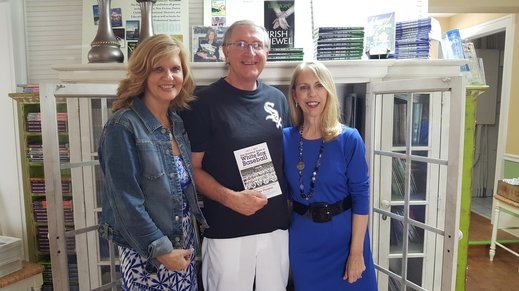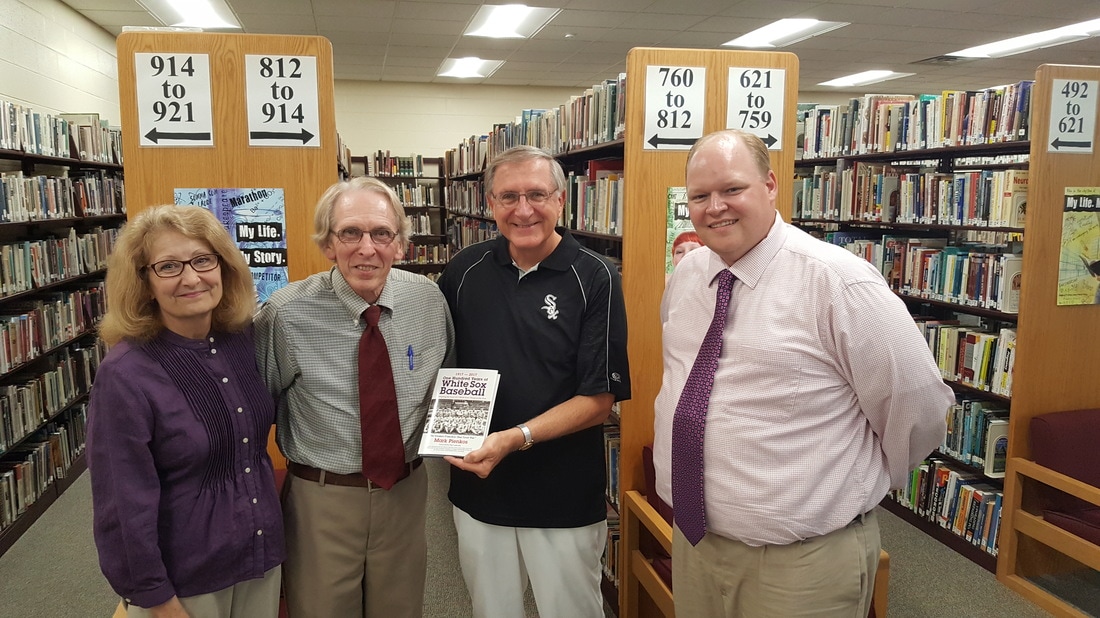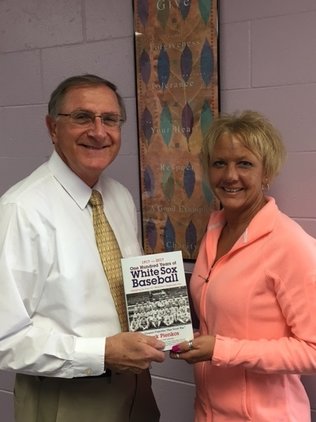1 Comment
Kathleen Vogt, Media Technology Specialist for the Washington-Caldwell School District located in Waterford, Wisconsin, interviewed author Mark Pienkos. Kelli placed the interview on the school district’s website and Facebook page, as well as submitted it to the local newspaper.
Kelli Vogt is a 2011 Kohl Teacher Fellowship Award recipient in the state of Wisconsin. Annually, 100 professional educators state-wide earn this recognition. Mark Pienkos is the past superintendent of the Washington-Caldwell School District located in Waterford, Wisconsin. KV ~ Mark, can you share what was the inspiration for writing your book entitled “1917-2017: One Hundred Years of White Sox Baseball?” MP ~ As a loyal White Sox fan, beginning when I was very young living and growing up on the South Side of Chicago, I wanted to share my love – my passion – for my favorite team. KV ~ Why do you start with a focus on the 1917 White Sox team? MP ~ Baseball fans – especially Chicagoans – will hopefully learn more about the great 1917 White Sox team that not only won the World Series that year, but also set a franchise record winning 100 games that still stands. Even the 2005 World Series Chicago White Sox team couldn’t match that feat, going 99-63. By the way, the 1917 regular season consisted of 154 games. Today’s seasons are 162 games long. So you can see the 1917 White Sox were special. KV ~ Besides winning 100 games and the championship, what else will baseball fans learn about the ’17 team? MP ~ That team was very special. The Chisox were made up of great players that were built to win not just in 1917, but for years to come. KV ~ How so? MP ~ The 1917 White Sox had three players that went on to be inducted into the Hall of Fame: second baseman Eddie Collins – one of the greatest all-time at his position – catcher Ray Schalk, and pitcher Urban “Red” Faber. Plus, I hypothesize that five other White Sox players were potential Hall of Famers, including leftfielder “Shoeless” Joe Jackson, who I believe – pardon the pun – was a shoe-in for the Hall. His .356 lifetime average is third highest all-time in Major League Baseball history. The other four were third baseman George “Buck” Weaver, centerfielder Happy Felsch, and pitchers Eddie Cicotte and Claude “Lefty” Williams. KV ~ What happened? MP ~ The 1919 White Sox club basically had the same roster as in 1917. The ’19 team won the American League pennant and faced the Cincinnati Reds in the World Series. The Chisox were heavy favorites going into the Series, which was extended to best-of-nine games to raise additional revenue for war-time baseball veterans. Unfortunately, eight of the players became involved in a betting scandal that led to the White Sox losing the Series to the Red five games to three. Suspicions of a “fix” began even while the Series was being played. Those suspicions continued into the 1920 season. Eight players were tried in a Chicago Cook County court to determine if they had in fact conspired to throw the 1919 World Series. With one week remaining until the 1920 season was to end – with the White Sox just 1/2 game behind the first place Cleveland Indians – the verdict of “not guilty” was declared. However, the next day, Judge Kenesaw Mountain Landis, the Commissioner of Baseball, ruled that any ballplayer who threw a game, conspired to do so, or had knowledge of this activity and did not come forward with information, would ever play professional baseball. Jackson, Weaver, Felsch, Cicotte, Williams, Swede Risberg, Fred McMullin, and Chick Gandil never played professional baseball again. KV ~ Had the White Sox not turned “Black” in 1919, you think the fortunes of Chicago baseball on the South Side might have been different? MP ~ I do. The White Sox of 1917 were built to win for a long time. With the players the Sox had assembled, I believe they would have added to their World Series title of 1917, in 1919, 1920 and who knows beyond. I ask myself the question: “Could the White Sox been a franchise to rival the New York Yankees?” My answer is, “Yes!” KV ~ What else will readers experience as they page through your book? MP ~ The book is actually divided into three parts. The first concentrates on the great 1917 White Sox team. The second focuses on one hundred years of baseball on the Windy City’s South Side – great games, great players, as well as my all-time favorite White Sox players. The third recounts my personal experiences following my team throughout my life, including my family’s attachment to the White Sox. KV ~ What are your hopes for the book? MP ~ I hope readers will enjoy learning more about the White Sox. I also hope that by reading my book, fans will re-live their own experiences – their own memories – following their favorite team, which I hope is the Chicago White Sox! KV ~ Thanks very much, Mark. Good Luck! MP ~ You are very welcome, Kelli. Go White Sox! Play Ball! On April 24, 2017, Dr. Mark Pienkos presented principal, Jill Saltzmann, the Washington Caldwell School Board and the school library with a copy of his new book, 1917-2017-One Hundred Years of White Sox Baseball: Highlighting the Great 1917 World Series Championship Team. The school library is excited to add this to the library collection!
 Peppertree Press Publisher, Julie Ann James and Editorial Director, Teri Franco, congratulate Mark upon the release of his first book “1917-2017: One Hundred Years of White Sox Baseball.” Mark and wife, Ann, were very grateful for all their guidance and patience through the publishing process. Mark autographed his newly released book at the Peppertree Press offices located in Sarasota, Florida on Friday, April 7, 2017. Thanks Julie Ann and Teri! Mark highly recommends Peppertree Press as an independent publishing house. Their full-house publishing services are amazing! GO WHITE SOX! Play Ball! |
Mark Pienkos
Dr. Mark Pienkos was born in Chicago. His parents were Stella and Edward who worked in factories to support their family of three boys. Mark’s mother only attended school through the 8th grade, while his father went to one year of high school. Mark’s oldest brother, Don, is professor emeritus at the University of Wisconsin-Milwaukee in Political Science and his other brother, Edward, is a surgeon specializing in urology. Archives
September 2017
Categories |


 RSS Feed
RSS Feed